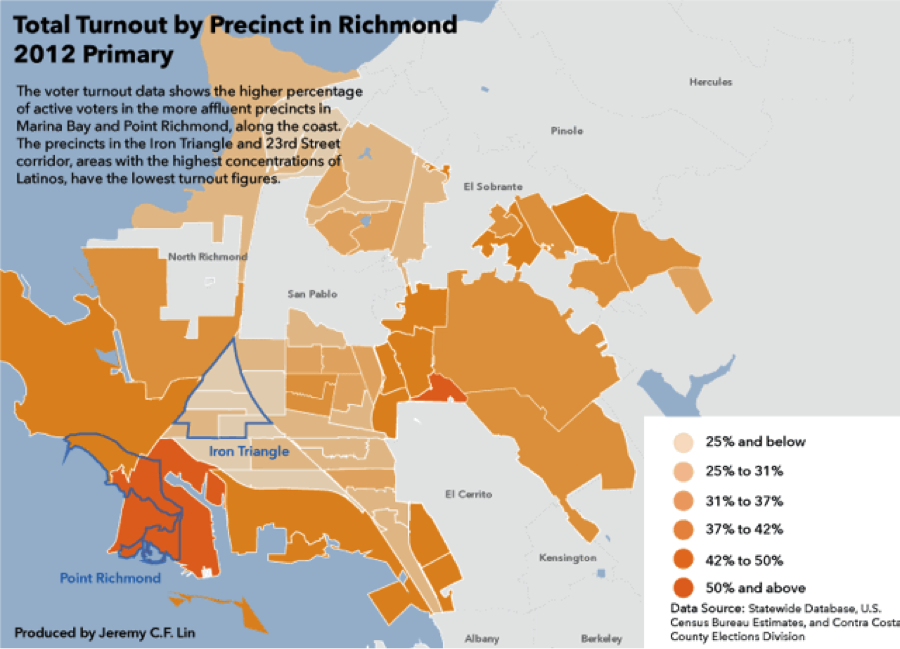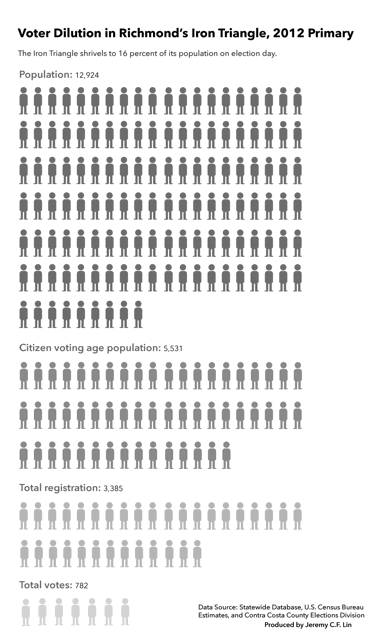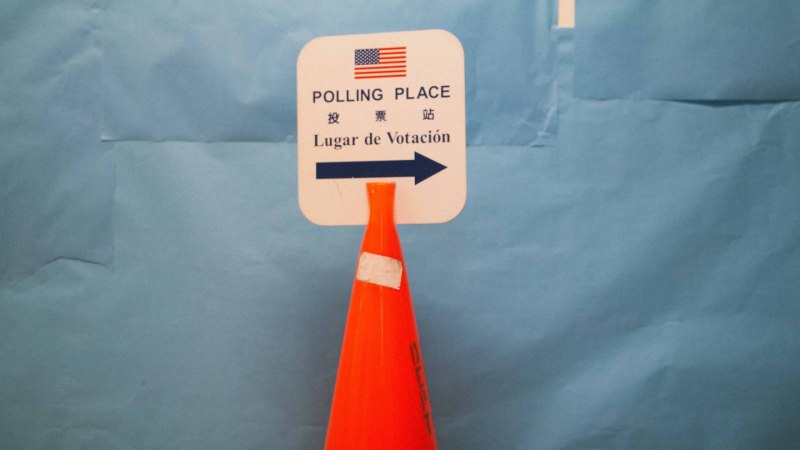When looking at the very visible political dysfunction of Richmond, political experts, activists and longtime residents say the city has a representation problem — from the “pork barrel” level, where potholes and flooding go untended, to widespread ethnic and geographic disenfranchisement.
They point to a broken political and electoral structure that favors wealthy constituencies and certain geographical areas over all others, compounded by what many consider to be symptoms of the system: deflated voter enthusiasm, low voter registration and even lower turnout.
“Right now, there are no lower-income constituencies [in Richmond],” said Robert Smith, a political scientist at San Francisco State University who’s been watching Richmond closely. “No one is representing their interests and frustrations.”
Flooding certainly isn’t a concern at the moment, but revisiting how the city represents itself may be.
On last Tuesday, Election Day, Richmond’s trending hashtag across social media was #RichmondVotes.
No, it doesn’t.
According to 2012 census estimates, Richmond has a population of about 104,000 people: 40,500 Latinos, 27,500 African-Americans, 19,000 whites, 15,000 Asians and about 2,000 “other” (not including unincorporated North Richmond).
Of the city’s 43,000 registered voters, fewer than 17,000 of them turned up at the polls—a sixth of the city’s population.
Tom Butt won the mayoral seat with 8,500 votes. The Richmond Progressive Alliance slate swept the council election; outgoing mayor Gayle McLaughlin, incumbent Jovanka Beckles and Eduardo Martinez were elected with around 7,000 votes each.
Compared with the last midterm election in 2010, voter participation has gone down. And in the 2012 primary election 14,300 voters came out, about 2,000 less than this year’s midterm total of 16,500. The 2012 fall election however, which had Barack Obama at the head of the Democratic ticket, brought out 34,000 voters.

Low turnout appears to offer the advantage to a small group of highly engaged voters and well-connected politicians (see charts). Incumbents, slate members and seasoned politicos play musical chairs in Richmond, a preservation of the status quo enabled by a fatigued, indifferent and often absent electorate. Before Tuesday’s defeat, council member Nat Bates had been in office for almost three decades, and he still has another two years on the council.
A LATINO MAJORITY IN NAME ONLY
In his concession speech Tuesday night, Bates pointed to poor voter turnout for the day’s disappointment. Shields-Reid Community Center near the North Richmond border had just 17 ballots cast by 5:30 p.m. “The African-American community doesn’t turn out unless it’s a national election,” Bates said. “There was no Obama this year.”
Although Tuesday’s voting demographics aren’t yet available, history says Latinos likely cast the fewest percentage of ballots relative to their population.
In the past, Richmond’s African American community—the majority a decade ago—has been well represented on the council.
But today, as in many cities in California and the Southwest, Latinos have become the majority in Richmond. But that majority shrinks to a small minority at the voting booths, according to an analysis of the U.S. Census Bureau and 2012 voter data from the Contra Costa County elections division, courtesy of UC Berkeley’s Statewide Database.
There are about 41,000 Latinos in Richmond, and some 7,000 (by surname) are registered to vote. But only 1,600 showed up to vote in 2012 (the latest year with available data). Among the other 63,000 non-Latinos in the city, 35,000 are registered and about 12,700 of those voted in 2012.
Latino turnout represents just 4 percent of its population while the rest of the city—white, African American, Asian and other residents—sees 20 percent representation at the polls. The number of Latino ballots cast hardly reflects its majority in the city.

It’s not just an issue of turnout, which compares voters at the polls to those registered. Many Latinos can’t register. The U.S. Census Bureau estimates a Latino citizen, voting-age population of about 12,500 in Richmond after excluding people under 18, those in prison or on parole, and the undocumented.
Quickly, the Latino majority turns to a minority come Election Day.
“Their part of the pie gets smaller and smaller,” said Nicole Boyle, a data analyst at Statewide Database, and the more consistently voting (white) demographics “fill in what’s left.”
The remaining sliver of Latinos on the City Council rarely come from the same stock or the same neighborhoods as the rest of the Latino population. “It’s a predominantly Latino population and a predominately white electorate,” said Andrés Soto, a progressive activist and longtime resident.
Last term, Jovanka Beckles was the only Latino with a council seat. In December, fellow Richmond Progressive Alliance member Eduardo Martinez will join her.
FLAWS IN AT-LARGE SYSTEM ATTRACT LEGAL CHALLENGES
Richmond votes at-large, an election system in which voters choose from a citywide pool of candidates who are meant to represent the entire city. For example, a voter in the Santa Fe area (20 percent voter turnout) sees the same ballot of candidates as a voter in the Point (54 percent turnout).
Coastal communities to the west and the Richmond Heights to the east -- similar in demographics and high in voter registration and turnout -- comprise the highlands that edge along the city’s border. Latinos make up less than 7 percent of registered voters in these areas; about 3 percent in the Point.
Last term, four of the seven council members lived in the wealthier edges. Mayor McLaughlin lives in the southern annex.
Moving towards the city’s center, turnout plummets as the Latino population rises. Their heaviest per capita concentration is along the 23rd Street business corridor, where half of registered voters have Latino surnames. The area is a business hub of several tightly packed pockets of small shops: mechanics, bodegas, taquerias.

Boyle said there are many socioeconomic factors also correlated with low-voter enthusiasm in Latino communities, including lower income levels, lower educational attainment, less home ownership and linguistic isolation.
It’s the exact precedent under which many activist groups have sued California cities, citing the state’s 2002 Voting Rights Act. The law, an expansion on the federal Voting Rights Act of 1965, makes it easier for California minorities to claim disenfranchisement in at-large systems that dilute their vote.
Since the passage of the California Voting Rights Act, it’s become increasingly popular for ethnic populations -- the sleeping giants -- to mobilize and sue for districts. And Richmond’s 41,000 Latinos could make a strong case for severe underrepresentation, said Karin Mac Donald, director of the Statewide Database.
So far, Southern California has been the nexus of these legal actions. From Compton to Palmdale, cities have dropped their at-large school board and council elections. Modesto was the first to fall in 2007, after a trial court ruled that minorities were being disenfranchised there, setting a precedent for several other cities.
Cultural factors, too, contribute to the disconnect between the Latino majority and a voice in government. Soto, the progressive activist, said the mostly immigrant Latino community in Richmond has long been disenchanted by politics. The corruption and violence associated with government in some Central American countries has turned them off to the whole idea of it. A citywide lawsuit isn’t something he sees them spurring.
“[Their experiences] really inhibited their belief in the political system,” Soto said. “It’s a take-care-of-yourself sort of thing.”
Sergio Rios, vice president of the 23rd Street Merchant Association and owner of Bob’s Cleaners, said he and the other mostly Latino business owners started the group because they thought it’d be an effective vehicle for getting things done without going through the city’s bureaucracy.
“We wanted to have this for ourselves,” he said earlier this fall. “I care about what the merchants think, not somebody high up downtown.”
If Richmond were divided into districts, line drawers would, in theory, place common interest groups like the 23rd Street merchants inside of one district to give them direct voting power and a distinct voice on the council, said Mac Donald.
The idea is to compartmentalize the needs and frustrations of an entire community, one at a time, represented by one council seat accountable to that small constituency. Their voices would become one, loud and present, instead of another part of the city’s cacophony.
WHO SPEAKS FOR THE IRON TRIANGLE?
Hugged between rail lines, Richmond’s Iron Triangle is one of the city’s most populous neighborhoods. Almost 13,000 mostly Latinos and African-Americans pack into less than a square mile in the heart of the flatlands.
A near perfect equilateral -- save for its Christmas-tree stump that dips down to Ohio Avenue -- the Iron Triangle is home to the city’s only hospital and a handful of parks and playlots. The BART station is tucked into the bottom right corner.
It’s cut off from the rest of town by Interstate 80, a thin stretch of industrial desert, and the converging iron tracks themselves, which account for, in part, the neighborhood’s name.
The people living between the tracks share something in common with the greater Latino community: the electorate, and in turn the council seats they choose, do not represent their population.
Despite the dense concentrations of residents, low-income neighborhoods of the city don’t put locals on the council. The Iron Triangle hasn’t had one in decades.
Most successful candidates come from the city’s edges. And the wealthier Richmond hill communities to the east and along the coast have cast a shadow over the flatlands, leaving tens of thousands without proportional representation—or, as in the case of the Iron Triangle, no representation at all.
Smith, the SFSU political scientist, said at-large systems tend to favor wealthier neighborhoods, where voter turnout is higher; more people who are registered to vote do indeed cast a ballot.
In the coastal precincts south of Freeway 580, voter turnout is 47 percent; 3,853 voters registered and 1,807 cast ballots.
In the Iron Triangle precincts, turnout is 23 percent. Of 13,000 residents (8,000 of them Latinos) there are only about 2,900 total registered voters and fewer than 800 go to the polls.
Less than one in 16 people in the neighborhood actually vote.

Smith said it’s like a negative feedback loop, where a history of underrepresentation and failed candidates begets voter apathy, which, in turn, lowers the next new candidate’s chances.
“At-large elections preclude the representation of distinct ethnic and geographic areas,” he said. “And they’re less favored today in terms of good government.”
Charles Smith (no relation), an East Richmond activist, has called at-large elections “the antithesis of participatory democracy … the middle class freely manipulating poor people.”
It’s the same story in North Richmond, the notorious unincorporated slice of land, often lumped together with the Iron Triangle in conversations about drugs, violence and poverty.
The Rev. Kenneth Davis, who tried to run for City Council as a write-in candidate, said these neighborhoods are off the government’s radar because nobody holds a personal stake there. Seventy-four votes went to the council write-in on Tuesday.
“They don’t give a damn about us,” he said.
Just south in the Iron Triangle, another reverend has similar feelings of abandonment. “Many of these people are suffering in silence,” said the Rev. Andre Shumake, an African-American community leader and anti-violence activist. “There isn’t that voice advocating on their behalf on the council.”
“We deserve a voice.”
The more than 12,000 unheard in the Iron Triangle—unregistered residents and Nov. 4 no-shows—make up what would be constituencies for local candidates running in the district system. Political scientists call this “the base,” and underfunded grass-roots candidates typically focus on building it.
But in the Iron Triangle, there’s not much to build on.
Still, it’s not uncommon for brave would-be representatives to emerge in the race, hopeful underdogs that have lived in Richmond’s toughest neighborhoods their whole life and made it. They are the success stories that try to inspire areas in desperate need of inspiration.
Tuesday, one such candidate from the Iron Triangle was on the council ballot.
Running for a long-term council seat, Dameion King had plans to change the way things are. But two weeks ago he knew he didn’t have much of a chance. “I’m realistic, but I want to get into the conversation,” the newcomer said. “There’s no education, no empowerment, and no dialogue.”
“If you don’t make an effort to educate the people, then you’ll have a deaf, dumb and blind community of people who don’t vote,” he said. “[Politicians] don’t want to inform and educate because that’s a sleeping giant, that’s an apathetic vote turned around.”
King got trounced, of course, hardly a blip on the electorate radar with 1,370 votes.
AT-LARGE VOTING HAS ROOTS IN IMMIGRATION BACKLASH
Most of today’s low-income residents are the grandchildren of Richmond’s immigrant waves of the 1910s and 1940s. And the sudden arrival of migrant workers from the South -- including King’s grandparents -- created a fierce political reaction.
“Bringing with them … socialist sympathies, immigrant workers helped spark a radical movement that challenged local business leadership,” writes Marilynn S. Johnson in "The Second Gold Rush: Oakland and the East Bay in WWII."
In Richmond, those workers were Southern sharecroppers, aggressively recruited by Henry Kaiser to drive his behemoth WWII shipbuilding endeavor at the port. The black immigrants were out from under Jim Crow, but still very much subordinate to white elites, who installed a political system that would ensure a concentration of power.
Johnson writes that cities all over the East Bay forbade the use of party labels on the ballot, “replacing the ward [district] system with citywide [at-large] elections.” This form of government, still in place today in Richmond (where it was first implemented in the 1909 charter) but abandoned by most of the Bay Area, “diluted the electoral power of ethnic and working-class voters.”
Betty Reid Soskin, a 93-year-old park ranger at the Rosie the Riveter National Park in the port, agrees that the city’s polarization is entrenched in its relatively brief history. Richmond’s modern birth was during the roaring 1940s, when the population boomed from just over 20,000 to almost 130,000.
“We’re still searching for an identity,” she said of the relatively young city. “It’s the story of California, but in Richmond it’s particularly stark.”
“We’re a collection of peoples with very little that binds us.”
DRAWING LINES
Drawing lines might be Richmond’s best chance of coming together.
Districts elections divide the city -- first by population, then by other criteria like “communities of interest” and language background -- said Mac Donald of the Statewide Database, which does redistricting for the state.
Then a small group of candidates, two or three from within that defined area, vie for one seat on the council. Usually the mayor, and possibly another seat, is still elected on an at-large basis.
“There are different ways to do it so everybody gets a neighborhood,” Mac Donald said. “Different ways to slice the pie.”
In her book "Tyranny of the Majority," Harvard Law School professor Lani Guinier compares the at-large and district systems with a high school prom committee:
• Ten students need to choose a five-song playlist for prom. Six like rock. Four want hip-hop.
• Under normal (district) circumstances, the group might choose three rock and two hip-hop songs.
• If they voted using the winner-take-all voting (at-large) method, all five songs would be hip-hop.
But some argue that the rest of the school might actually want hip-hop. A Point Richmond resident, who asked not to be named, said people voted in at-large “can better represent the needs of the whole city.”
It’s not a new sentiment.
District elections were put on the ballot once in 1991, lumped in with the other election reforms under “Measure K,” and ultimately rejected.
A Point Richmond political group spearheaded that measure at a time when the council was held by a majority of African-American politicians from the old “South Richmond,” who fought tooth-and-nail to keep it from passing.

Since then, as the locus of political control shifted across the freeway, the conversation has floated around but never made it to the ballot again. The measure would be an amendment to the city’s charter, requiring either majority council support or about 4,200 signatures (10 percent of registered voters) to reach the ballot.
Twelve years ago, then-Councilman Tom Butt told the Richmond Post, “I don’t particularly like the idea. …Whatever the city does should be what is best for the entire city not just parts of the city.”
The narrative of close-guarded power has repeated throughout the years -- those elected on at-large basis defend the ladder they climbed.
Today, Mayor-elect Butt, a Point Richmond native, still has misgivings. “I’m not sure there’s a significant group that’s not adequately represented,” he said. “You’d be setting up for a fight, neighborhood on neighborhood, and we don’t need to exacerbate that.”
Echoing some of its opponents, Douglas Johnson, president and founder of the research firm National Demographics Corp., said he’s noticed some divisive enclaves forming in cities that have recently dropped their at-large elections. “Districts can drive a wedge and pit neighborhoods against each other,” he said.
But McLaughlin said districts could create “truer democracy,” though it first merits conversations with the 35 neighborhood councils, she added. The small groups of civically engaged citizens can be powerful lobbying agents in the city.
Former Iron Triangle neighborhood council president Shumake said districts “would see a groundswell of support” at the street level.
He cited the BART station and Macdonald Avenue revitalization projects as examples of rank-and-file, neighborhood council-led initiatives that have benefited all of Richmond.
“If you give each community someone exclusively responsible to them, that community will thrive,” Shumake said. “Then the whole city will thrive.”
Graphics by Jeremy C.F. Lin





